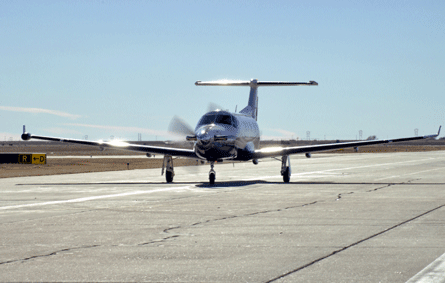A small fleet of manned propeller-driven spyplanes is being rushed into action by the US Air Force. The fleet will be equipped with signals intelligence sensors and cameras that will eventually provide a substantial increase to an urgently needed full-motion video capability in Afghanistan and Iraq.
Three squadrons of RC-12 turboprops - likely to be twin-engined Beechcraft King Air 350s - could join other surveillance aircraft in January 2009 in a USAF programme dubbed "Project Liberty".
The programme is being run through the USAF's Big Safari special projects office, which developed the super-secret YMC-130, a Hercules transport modified with rockets allowing it to take off and land on short runways. That aircraft was designed to rescue Americans held hostage in Iran in the early 1980s.
Big Safari officials plan to modify 37 King Airs in a little more than a year.
Ongoing operations in Afghanistan and Iraq have taken a toll on the service lives of fighter jets that 90% of the time never drop a bomb, let alone engage a near peer in a dogfight. Commanders and programme officials in the USA routinely say the operational tempo is forcing them to "fly the wings off" Lockheed Martin F-16 and Boeing F-15E fighters and other aircraft that were built to drop bombs, jam communications systems and fly head-to-head against enemy aircraft.
Instead, these aircraft - in addition to unmanned air vehicles - have been given high-tech targeting pods and datalinks that can beam live video from the aircraft to troops on the ground - pictures that can identify insurgent hiding places and discover improvised explosive devices buried in the ground.
SENSITIVE EQUIPMENT
The situational awareness provided by such systems is leading the charge to use turboprops outfitted with sensitive intelligence equipment similar to that typically found on Boeing 707-based RC-135 Rivet Joints, which have been continuously flying operations in the Middle East since 1990.
The Project Liberty effort comes in direct response to an initiative by defence secretary Robert Gates to put more intelligence, surveillance and reconnaissance aircraft in theatre. Earlier this year the Pentagon's top official created an ISR taskforce to address that issue.
Congress has also advised the USAF to look at low-tech assets that could be beneficial on the battlefield. In a May report accompanying a Senate Armed Services Committee review of the yet-to-be-approved fiscal year 2009 defence authorisation bill, lawmakers said manned aircraft could give ground commanders better situational awareness than military UAVs already on the battlefield.
Acquiring UAVs takes time, especially as the USAF trains the majority of UAV pilots at the same US location where it also remotely operates the aircraft deployed in theatre. In addition, service officials maintain that their UAVs use video-gathering sensors that give operators a limited field of view.
The baseline configuration of the new aircraft will be similar to Beech C-12s already operated by the US Army and Special Operations Command.
USAF documents reveal that the Project Liberty aircraft will have Wescam MX-15 electro-optical/infrared full-motion video sensors, signals intelligence sensors, video downlink, self-protection systems, "Blue Force" tracking and an on-board full-motion video storage unit.
Together these sensors will provide real-time situational awareness to troops on the ground. A four-man crew made up of two pilots and two sensor operators will operate each aircraft. The crew will report to intelligence analysts embedded with an army brigade combat team or a USAF tactical operations centre.
The RC-12 effort is just one of several low-tech-type US initiatives officials hope will produce results on the battlefield. The Air National Guard has spent more than $2.8 million to purchase a Beechcraft AT-6B attack aircraft, which it is expected to receive in 2009. In addition, the Special Operations Command has increased its non-traditional air fleet spending to buy Pilatus PC-12s.
 |
|---|
© US Air ForceThe US SPecial Operations Command has shopped for Pilatus PC-12s as military chiefs begin to realise the value of turboprops on battlefields |
The US Special Operations Command has shopped for Pilatus PC-12s as military chiefs begin to realise the value of turboprops on battlefields
Source: Flight International
















